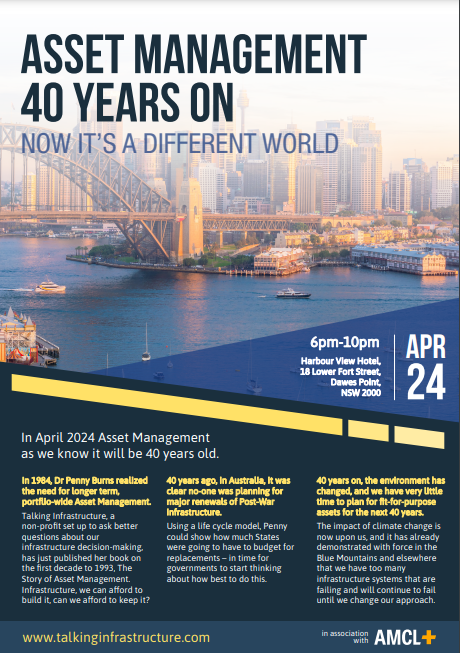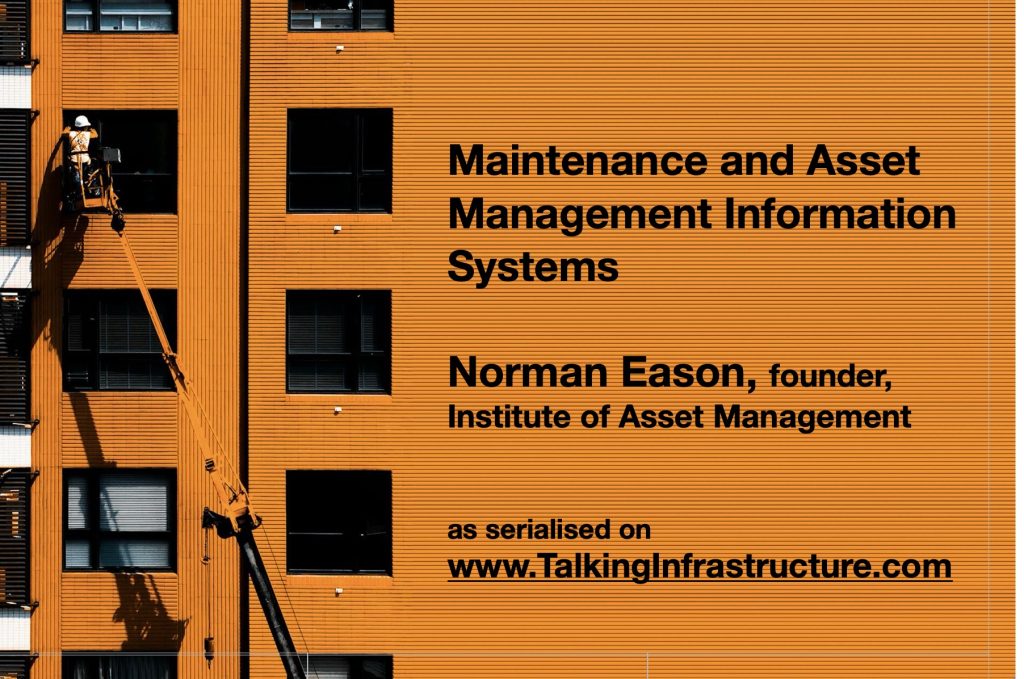
Penny and Ruth at AM Peak gala dinner, April 16 2024
Since I last posted I have spent a month celebrating 40 years of Asset Management in Australia with Penny, Jeff and Gregory; gone to one of my favourite conferences in Minneapolis; taught an advanced AM course to some sophisticated AM practitioners in Calgary, as well delivering to as a post ISO 55000 certification client in California.
I have been thinking about where AM needs to go next, at the same time as worrying that things have not moved far enough.
And it just keeps coming back to: We Need to Raise our Game. And not because what Penny kicked off four decades ago hasn’t made a huge difference already.
But I want us to do more.
First, to effect what Penny set out to do through Talking Infrastructure: to look up and out, to make a difference to key decisions on what infrastructure we really need.
Secondly, as I start to unwind from delivering basic AM training – something I have loved doing for nearly 14 years now – I reflect on our competencies.
This kicks off a series of questions and reflections on what we want to change, and how to do it.
How to interest existing AM practitioners in upskilling on risk, data analysis, culture/ system change, persuasion, strategic thinking?
How to find people who want to challenge the status quo on infrastructure projects?
What can we best offer from our collective experiences to support better decision-making?
I am looking forward to this!

“ It was great to celebrate Asset Management’s 40th year with many old friends and new, a celebration that started with AM Peak in Adelaide and finished with the IPWC Conference in Melbourne. At both ot these gatherings about 30% of the attendees were women, mostly young women, such a very good sign for the future of AM. Also good signs of ethnic diversity. I recalled the beginning of both associations and so had occasion to reflect on how they have grown and developed over the years.
In between these events I was able to spend time in Brisbane and meet with AM friends and colleagues of #Chris Adam at Stantec and #Joe Mathew at QUT, while enjoying the company of my long time friend #Kerry McGovern. Then it was on to the Blue Mountains to meet #Lis Bastian and to stay with #Jeff Roorda, Infrastructure Director with the BM City Council. This was shortly after a major landslide had caused the collapse of the only road into Megalong Valley. A new temporary road was built within days but was only able to cope with light traffic putting Jeff in the position of dealing with simultaneous environmental, economic and social disasters in this very beautiful and highly sensitive area. Then just a day ago came news of a sink hole in a Sydney suburb, the result of heavy rains and it is likely that many more of us will be dealing with triple disasters soon.
The truth is that across the country we are facing major challenges and major change and much that we think we know now needs serious reconsideration. I am now taking a Sabbatical or “Time Out” for the next six months to research and reflect on what those of us in the Infrastructure and Asset Management game can do, but I am happy to receive your ideas If you are also concerned.
PS. I have today done what I should have done weeks ago and that is to upload all the remaining chapters of Norman Eason’s “Maintenance and Asset Management Information Systems“. Now this link will get you the lot! Do have a look. I am sure that you will be surprised by how much you can still learn from work that was written 25 years ago! Then the idea was to develop understanding so we tackled the ‘why’ of different issues. Today the emphasis has been on the ‘how’. But the ‘Why’ is still critically important – because likely different .

Come and meet Penny and Talking Infrastructure in person! Watch this space for additional details, but here’s the programme so far:
April 15 & 16 AMPeak, Adelaide. Penny and Ruth will be at AMPeak.
April 18, Stantec, Brisbane
April 19, PACoG, Brisbane. Asset Institute, QUT, 11am- 12.30, followed by lunch. Join Joe Mathew and Kerry McGivern along with Penny and Ruth to discuss what we’ve learnt in 40 years – and look forward to the next 40. Includes a look of what is happening with asset management internationally, in this big year for AM.
April 23, Blue Mountains City Council, Katoomba, 10am to noon. Seminar with Jeff Roorda on Blue Mountains City Council planetary health and disaster recovery experience, plus update on the new advocacy project underway by IPWEA Roads and Transport Directorate (IPWEA RTD – NSW/ACT), on Lessons Learned from Disaster Recovery, to assist NSW Councils work with Local, Strate and Federal Government Agencies.
April 24, Sydney event, Dawes Point. 6-10pm Harbour View Hotel, 18 Lower Fort Street, Dawes Point, NSW 2000. Using the recent experiences of the Blue Mountains City Council, Talking Infrastructure is holding an event in central Sydney to call for urgent changes in all of our asset mindsets and tools to ensure planetary health, biodiversity and climate change resilience. Meet with Penny, Jeff, Gregory and Ruth, plus local IPWEA. Food provided thanks to AMCL.
April 30, IPWE, Melbourne. Presentation by Penny. Penny and Ruth will be at IPWE until May 3. There will also be a dinner out in Melbourne for TI friends and colleagues – please let us know if you would like to join us. And bring along your copy of Penny’s book to get signed!

If you are planning to attend our Sydney celebration, please RSVP to: amis40@talkinginfrastructure.com so we can keep an eye on numbers – limited to the first 60! Event is free, includes food and discussion with Penny Burns and Jeff Roorda and a whole heap of old friends and colleagues.
Full update of the 40th year celebration events shortly!

Join us at the Harbour View Hotel in the Rocks and help celebrate with finger food and drinks – plus Penny and Jeff on what we have learnt from the last 40 years to help us meet the challenges of the next 40.
Many thanks to Richard Edwards, Lynn Furniss and Matt Miles of AMCL
Today we uploaded Part 4 of this serial. See what is available – and come back next week for more. .. May 15. All remaining parts have now been added. This is now the whole thing. Enjoy!

CONTENTS
Chapter 1, p.01 Scope of this book – what’s in it and what’s not
Chapter 2, p.12 Maintenance and Asset Management – the difference between them
Chapter 3, p. 22 Data and Information, Pt 1 – not the technology but the use
Chapter 3, p. 35 Data and Information, Pt 2 – differing needs of Maintenance and Asset Manaagement
Chapter 4, p.45 Objectives of Maintenance and Asset Management Systems – differences due to the attitudes of company management and maintenance operations
Chapter 5, p.58 The nature of the problem – and the problem of lock-in
Chapter 6, p.71 Codes – the way an organisation describes itself in an information system
Chapter 7, p.83 Functions – how to ensure the functions you need are fhe functions you get
Chapter 8, p.87 Technology – trends to be aware of
Chapter 9, p.99 Culture – a new and different framework for thinking about information systems
Chapter 10, p.110 Evolution – when does the implementation of a new system end?
Chapter 11, p.120 Interconnection – maintenance systems are not the first to be computerised
Chapter 12, p.130 Methodologies – with the maturity of methodology comes a new are of divergence
Chapter 13, p.135 Traditional approach to product development – evolution v revolution
Chapter 14, p.142 Successful procurement for through-life effectiveness – 5 areas that need to be addressed
Chapter 15, p. 172 Objective assessment of progress – productivity is the act of bringing a company closer to its goals.

Penny Burns and Talking Infrastructure will be on the move in April to celebrate 40 years of Asset Management, and look forward to the next 40.
Adelaide April 15 & 16, Penny and Ruth will be celebrating at AM Peak.
Brisbane events April 17-19
Sydney April 24, venue TBC: Asset Valuation in a time of Climate Crisis. Including Jeff Roorda on how Blue Mountains City Council is taking a radically new approach, as well as Penny on how we must rethink our AMP modelling.
Melbourne April 30, IPWC. Penny speaking on the opening morning of IPWEA conference
Wellington May 4-6, events to be announced
Let us know if you are interested in meeting up in any of these cities.
See you in April! #AMis40

Nobody likes being told what to do. So ‘Maintenance and Asset Management Information Systems’ doesn’t. Norman Eason’s vast experience and insightful observations will simply help you think it out for yourself! Much more enjoyable.
Part 2 of our serialisation of Norman Eason’s ‘Maintenance and Asset Management Information Systems’ addresses the problem of data into information.
My own experience – and I suspect yours also – is that when data storage became so cheap as to be ignored, we also tended to ignore data relevance. Early tendencies were to collect whatever we could – and figure out its use later. Are we still doing this?
Are you really sure?
Why not check? In Part 2 of Norman’s book, now available on the Talking Infrastructure website, Norman addresses the practical needs of both maintenance AND asset management – and makes a clear distinction between the two.
His work is easy, and it is fun to read.

Norman Eason, founder UK IAM, was not only an information systems innovator but a business strategist. Great combination!
We are now serialising Norman Eason’s major work “Maintenance and Asset Management Systems” and chapters 1-3 are already available. Don’t miss this.
I first met Norman in 1996 and later interviewed him for Strategic Asset Management when he visited Australia in 2000. In 2002, he came to Heathrow airport to see me off and gave me the manuscript of this work to edit and use ‘as I saw fit’. I felt enormously privileged to be entrusted with this work. So I did a light edit and in 2004 I published it, serial fashion, with side annotations, a chapter a week on my original website.
In the twenty years that then passed, that website was closed and I lost the original. It was only after he died, and thanks to my friends, Geoff Webb, who had printed out the entire thing as it was being published and sent me his hard copy, and Kerry McGovern, who patiently scanned the whole thing for me, that I again have a copy that I can share with the Asset Management Community.
Re-reading this work now makes me even more appreciative of Norman’s insight. For example, even some 30 years ago, when many were still thinking that asset management was simply ‘maintenance plus’ he was urging his readers to consider that:
‘movement from a traditional maintenance operation to asset management will take much more than the procurement of an asset management information system; it requires a fundamental change in culture that could take years to achieve. Indeed, the procurement of an asset management information system by a traditional maintenance operation without an accompanying change in culture could have a negative, rather than a positive, effect on the organisation’.
This is a message which is as relevant today as it was then. So don’t miss our serialisation of Norman’s work. It seems appropriate that after 20 years, we again make this available – and in the original web format. So enjoy!
Chapters 1-3 are available now.

Don’t be! Today we start a new serialisation of “Maintenance and Asset Management Information Systems” by Norman Eason, founder of the UK Institute of Asset Management whose ideas are as useful now as when he wrote them when Asset Management was at its beginning.
See Chapters 1-3 Here.
Norman Eason died two years ago today, February 24th. Not only was he the founder and first president of the UK Institute of Asset Management, he was the most innovative thinker of his time on the subject of information systems. He was one of the earliest to apply computer technology to maintenance and his Rapier system won a European Award in the early ’90s.
When he realised that companies were buying computerised maintenance systems without having a maintenance strategy and without linking their information requirements to their business, he decided it was time to address this serious issue, which led to his lobbying and the founding of the IAM in the UK in 1995 of which he was their first President.
It also led to his writing one of the most interesting books on maintenance and asset management information systems you will ever read.
In 2002 he gave me the manuscript of this work and asked me to do with it whatever I could as he now wished to spend his time in his garden. So I lightly edited it and, in 2004, I serialised it on the amqi.com website but did not keep it permanently available in case he should change his mind and decide to have it professionally edited and published. But he never did. Which is a pity since it is such a valuable work.
It was his view that the reason for procurement of an information system for maintenance or asset management is to make use of the information that it accrues. Pretty basic, but there are signs that some have forgotten what should be obvious
“The system should be a fundamental part of the Data to Wisdom Ladder – Data, Information, Knowledge, Wisdom – and the choice of the system will determine its effectiveness. Without an awareness of how data and information interact and how best they can be managed, no system will be effective. Chapter 3 addresses this subject and also introduces the concept of data as an asset, whereby users of information systems are encouraged to view data (and information) as valuable company assets that should be managed in a similar way to all other corporately important assets”

Recent Comments